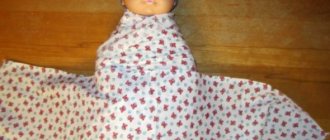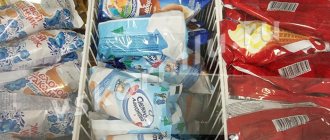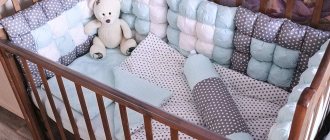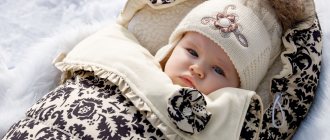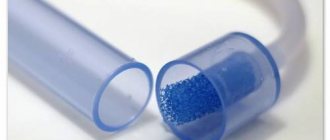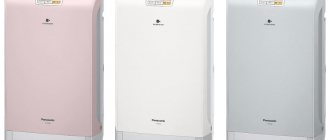Good day everyone! Tell me, did you buy baby clothes before the baby was born? After all, many mothers are very superstitious in this regard. Not every pregnant woman goes to baby stores before the baby is born. And after discharge from the maternity hospital, something important may not be at hand.
One of the attributes is a blanket. I myself am quite superstitious, but this item was one of the first to be purchased, even before my baby was born. And if you have little time left before the baby is born, I will share information on how to choose a blanket for a newborn. Shall we start?
What should you pay attention to?
There are many subtleties that need to be observed to ensure that the baby is satisfied. Such a small creature! How to treat it after birth? There was a mother with me in the maternity hospital, who was afraid to approach her own child. I ran after the nannies, arranged for dad to be allowed into the room... Who knows, perhaps it was postpartum stress or the fear of harming the baby out of ignorance! To avoid such fears, you need to arm yourself with knowledge about caring for babies and choosing things for them!
Of the things, a blanket is almost the first on the list! What to focus on when choosing it?
- Seasonality. When is the replenishment expected? For summer kids, you can buy a light version for now. And for winter, it’s better to immediately arm yourself with two types: warm and lighter. For example, we bought a practical envelope, where the main element was an insulated blanket (daughter in autumn). But they didn't use it often. Why? It was quite warm in the room. And it quickly became frosty outside. And on the contrary, it was too cold for frosty weather.
- Room temperature (especially in winter). In private homes, you can adjust the thermometer readings yourself. But in apartments this is more difficult. How do you sleep in winter yourself? In general, we covered him with a simple insulated diaper.
- Dimensions. There are very small ones: 80*90, and there are large ones 110*140. If the baby was born in the summer and you are already buying for the winter, take more. Kids are growing up fast! The main thing is that it fits in the crib.
- Ease. Even warm models should have this quality. The newborn is very weak and vulnerable. There is no need to weigh it down with tons of blankets.
- Good air exchange and hygroscopicity. The baby should not sweat or freeze in his sleep!
- Hypoallergenic. Give preference to either artificial materials or natural ones that do not cause allergies.
Based on these criteria, you will select the desired position. But what are you going to use the blanket for? To cover the baby? Did you know that a bedspread performs several functions?
Varieties
Baby blankets come in open and closed types, of different weights and compositions. A blanket for a newborn in summer should be light.
Warm models are produced for the cold season. For the winter period, it is better to choose a product made of fur, down, wool or padding polyester. Knitted, cotton, fleece or flannelette models are suitable for autumn.
In hot weather, it is better to use light blankets with good hygroscopicity - made of fleece, bamboo, jacquard, flannel, cotton.
Wool models
Made from camel, sheep, merino and goat wool. The top of the blanket is covered with thick natural fabric. There are knitted products that are more suitable for walking outside. They look original. The only drawback is that they can cause allergies. Children with individual intolerance to woolen items are not recommended to buy such blankets.
Quilts
They are in great demand because they are made from cotton wool. They warm well. Environmentally friendly products. Excellent moisture absorption. They are easy to care for. The disadvantages include: relatively heavy weight, the blanket can change shape after washing and takes a long time to dry. They often cover children during a walk, and also lay them on sleds in winter.
Synthetic products
Various artificial fibers can be used as filler: ecofiber, holofiber, synthetic winterizer, silicone, Thinsulate. They provide comfort and are pleasant to the touch. They are characterized by low cost and good quality. Keeps you warm. The products can be washed frequently and dry quickly. The main disadvantage is considered to be poor hygroscopicity.
Made from fleece
The products are characterized by light weight, comfort, and do not cause overheating of the body. The downside is the ability to accumulate dust, which can cause an allergic reaction. The blanket is easy to wash. Dries quickly.
From calico
Products are light in weight and soft to the touch. They retain their original appearance for a long time. Contains natural fibers. Most often used in summer in cool weather to warm the baby.
Made from fluff
Made from swan or goose down. The cover is sewn from dense natural fabric and quilted. The models are light in weight and have good hygroscopicity. They let air through and keep you warm. In cool weather, the child is covered during a walk. Disadvantages: delicate care is required, during washing the filling gets lost, the item becomes deformed and takes a long time to dry.
Made from bamboo
Summer and demi-season models are made from bamboo. The products do not cause allergic reactions and do not lose their original appearance for a long time. The only negative is the high price.
Knitted products
Convenient to use while walking or visiting. They are characterized by lightness, original appearance and a long period of operation. Made from threads of both natural and synthetic origin. Easy to wash and dry.
It is not advisable to choose a small size blanket for a newborn, because intensive growth is observed in the first year of life. It is better to be guided by the parameters of the crib. The minimum width is 60 cm and the length is 120 cm.
Attention. These sizes are not suitable for walking. It is difficult to wrap a child in such a product.
The optimal options for a crib are the following sizes: 80 by 100 cm, 90 by 120 cm, 115 by 105 cm, 135 by 100 cm. Blankets with parameters 110 by 140 cm have been used for several years.
Flannel blankets for newborns are popular. This pile material is soft to the touch. The composition varies. Products are made with the addition of wool and cotton. Sometimes natural fibers are combined with a small amount of synthetics, such as viscose.
This is useful to know
An envelope blanket is suitable for discharging a newborn from the hospital. There is a large selection of these for all weather conditions, from different fabrics, with clasps, rivets and buttons. The product should not cause discomfort to the child.
Blanket functions
If you are hoping to buy one product for all occasions, I will disappoint you. Suppose a child was born in winter. It is clear that you need a good-quality and warm model to go for a walk or go to the clinic. Are you really going to shelter your child after the hospital? I doubt! Why are there foreign microbes in the crib? What else do we need a blanket for?
- Cover when the child is sleeping.
- For walks. On hot days you can do without it.
- Place on the floor. Do not be surprised. After a few months, the baby will begin to sit and crawl. Where to study the world around you, if not on the floor?
What are manufacturers ready to offer?
Video: how to sew a winter blanket for a baby with your own hands
This video will tell you how to sew a blanket for a newborn with your own hands.
It happens that the child behaved wonderfully and wanted to sleep. They put him in a crib and covered him well, but after a while he begins to be capricious. The reason may be an incorrectly selected blanket. The baby feels uncomfortable and hot under it. Therefore, you need to be sensitive to the condition of the baby and carefully choose bedding. Recommendations on how to choose a set of bedding for newborns in a crib can be found in this article. Then the baby is guaranteed healthy sleep.
Fillers and materials
The blanket can be fabric or stuffed with filling. In any case, you need to pay attention to the material. We initially bought synthetic products for our daughter. Holofiber padding, knitwear on top. The blanket was immediately prepared and warm for walks. But he was then sent to the floor when we started to sit. We walked in wool (thanks to the grannies!). Fortunately, there were no allergies, so I was satisfied! Just right in cold weather!
In general, there are 2 types of bases:
- Synthetics. Don't be afraid of this word! Naturalness is good, but in this case it can easily provoke allergies. For the first time it is better to try artificial ones.
- Natural. Wonderful choice! If only all sorts of bugs didn’t like to live here. Because of this, blankets require careful care to prevent animals from getting their hands on them. Adults can be destroyed by washing and steaming. But their eggs are not always there.
These species are then divided into winter and summer. What do manufacturers offer? What bases are used? Let's first look at the variations for winter.
Thin blankets for the summer season
Let's look at the varieties offered by manufacturers depending on the age of the child. It is worth noting that choosing a blanket for a newborn has its own nuances and characteristics.
- Envelope. The first blanket for babies is an envelope. Or rather, it serves not so much as a sleeping accessory, but rather as clothing, because its convenient design allows you to quickly dress and undress your baby, avoiding temperature fluctuations. The seasonality of its use will help you choose a suitable envelope. In the demi-season, single-layer ones are suitable, while in winter you will need at least two layers: fur and water-repellent.
- Transformable blanket for a growing baby. The design of this sleeping accessory has the shape of a bag, which allows the baby to feel freedom without being exposed. The advantage of such a “cocoon” is that parents do not need to get up at night and cover the child. For little ones who like to sleep in the fresh air, such a transformer will help avoid drafts.
- A blanket, as a type of blanket, is used for walking in a stroller in the fresh air during the cold season, and can also be used as a bedding for children under 3 years old.
- A blanket in the usual meaning of the word can be introduced into a child’s everyday life from the second half of life.
Before choosing a blanket for your child, you should first familiarize yourself with the possible filling options.
Materials used as filling for children's blankets are the same as those used for adults. Which blanket is best for a child, which one to give preference to is decided by parents, having previously analyzed all the pros and cons of each.
Natural
The cotton filler used in the budget range is natural, but a bit heavy. Cotton wool absorbs moisture well and retains heat, which is an advantage of this material. Among the disadvantages are poor breathability, the ability to absorb and retain various odors. You can buy it as a backup option, but do not use it constantly.
Covering children under three years of age with a cotton blanket is not recommended. If the goal is to choose a wadded blanket for an older child, then it is better to give preference to quilted options.
Blankets made from camel, sheep, goat, merino or alpaca wool, which have high thermal conductivity and hygroscopicity, will perfectly warm him without making him sweat. This option is suitable for babies from the first years of life, when heat transfer control is so important.
Down filling provides excellent warmth during the cold season, but can cause an allergic runny nose or cough in a child. The warmest of the entire range offered are “down jackets”, which contain the down of waterfowl: loons, swan, goose. They retain heat well and have good breathability. The advantages also include softness and durability.
But, despite the numerous advantages, you should refrain from purchasing them for children prone to allergic reactions. The reason for this is not the fluff itself, but the bed mites that grow in it after prolonged use. In this case, it is better to buy a blanket made of synthetic fiber or bamboo. Also, down ones are not recommended for use by children under two years of age, thereby avoiding overheating.
Bamboo occupies a leading position among natural fillers. Due to the antibacterial substance it contains, the development of bacteria is practically excluded even after fifty washes. High thermal conductivity allows you to cover yourself with a bamboo blanket in any season. Choosing its size is not difficult: the length of the bed plus a small margin for the volume of the product.
Silk is an elite and one of the best fillers. It does not accumulate dust, does not harbor mites, and fully meets the requirements of children prone to allergic reactions. Among the undeniable advantages are high wear resistance and hygroscopicity.
Its high price is fully compensated by its quality characteristics and long service life. But the material is quite difficult to care for and must either be ventilated or carefully washed with special products. In addition, such a product does not “like” people jumping or running on it, while the favorite place to play for most small children is the bed.
Synthetic
There is no clear answer as to which blanket is optimal for children. After all, you also need to take into account the temperature in the children's room. If it is cool, then the choice is made in favor of down or wool, but if it is warm and the child is prone to allergies, then it is better to give preference to a synthetic filler.
The choice of synthetic fibers for bedding is very wide, the most common are: synthetic winterizer, Thinsulate, silicone, holofiber, fleece.
Sintepon is the most affordable among synthetic fillers. Lightweight, it retains its shape for a long time after washing. When purchasing a padding polyester blanket, it is better to give preference to well-quilted models, which will further contribute to its durability. The material is comfortable to use, but does not allow air to pass through very well.
Holofiber is the best synthetic filler today. Its popularity is explained by its lightness, splendor, warmth, ease of care and affordable price. It does not harbor bed mites. A plus that holofiber deserves to like is its long-term retention of shape with repeated machine washing and steam treatment.
In the warm season, it is customary to use light blankets and rugs. Thanks to their cotton components, terry and flannelette blankets or knitted blankets will keep your child from freezing. It is also worth noting fleece products, which are often used as bedspreads for children's beds. Soft and pleasant, they retain heat perfectly.
All of the above recommendations will allow parents to choose the right option that will allow their children to sleep warm and comfortable.
We also recommend reading: How to choose a heater for a child’s room.
A blanket for a newborn should be light, hypoallergenic and pleasant to the body, and the materials used in production are safe for the child. The following companies' products meet these requirements:
- Kariguz has been producing products from high-quality down and feather material for more than 26 years. The company's products comply with GOST and international quality standards.
- Farla Dream – produces blanket envelopes for newborns. Received certificates of compliance with GOST and the international quality certificate OEKO-Tex Standart 100.
- Primaville has been producing blankets for over 15 years. In addition to standard materials, it uses natural phyto-fillers from corn and bamboo. The company's products have received declarations of conformity with the technical regulations of the Customs Union.
- German Grass – produces luxury goods of Austrian quality. In production it uses environmentally friendly and anti-allergenic materials.
Silk
Silk blankets are durable and strong and can be used at any time of the year. Moreover, they are not “loved” by dust mites, which can cause an asthmatic attack and a rash in a child. Such products do not cause allergies in children. The main disadvantage of silk blankets is their high price.
Pooh
Duck or goose down is most often used in production. This is a warm and light material, elastic and pleasant to the touch. But down comforters are not recommended for use on babies, as they often cause allergies and can harbor mites and mold.
Wool
This material is used when sewing winter models. It warms the baby perfectly and maintains the desired temperature. Wool blankets are well ventilated, allowing the baby's skin to breathe. They are highly hygroscopic, i.e. absorb and evaporate moisture. Under such a blanket, the child will not wake up sweating. However, wool can cause allergies in some people and can harbor dust mites.
Bamboo
This filler, like wool, is highly hygroscopic. It does not cause an allergic reaction in a child; it does not harbor mites or fungi. In addition, bamboo blankets have a breathable structure, making it warm and comfortable to sleep under. Another advantage of bamboo is its lightness - even the largest blanket 220x240 weighs no more than 1.5 kilograms.
cotton wool
This hypoallergenic and warm material is often used to create winter blankets for children. But it absorbs odors and eventually clumps into clumps. A cotton blanket is not recommended for use on newborns, because... it is too heavy and does not have the required hygroscopicity.
Read more: How to choose a clothes steamer: ranking of the best
In the production of blankets for winter and summer, synthetic fillers such as holofiber, ecofiber and Thinsulate are often used. Holofiber is lightweight and highly wear-resistant, while ecofiber has an elastic structure, durability and breathable properties. Thinsulate is considered one of the lightest synthetic materials.
A blanket for a child should be made of hypoallergenic materials.
People of the older generation remember the times when, in search of children's bedding, as well as clothes, they had to go around more than one store. Today, trade counters are literally littered with textile goods, and it is very difficult for a buyer without appropriate preparation to choose the right model.
When buying a blanket for a child, you need to pay attention to the following nuances:
- Time of year when the product will be used. In addition to the fact that blankets come in winter and summer, there are combined and double-sided models. The 4 Seasons model consists of two separate parts connected by buttons or a zipper. If the room is very cold, you can use the entire product. When the air temperature rises, it is enough to unfasten one part - and it will not be hot to sleep.
- Product weight and size. A baby blanket should be light and not too big. The standard size of this bedding for children under 3 years of age is 110x140 cm. Products filled with eiderdown or goose down or synthetic fibers are considered lightweight. Models filled with cotton wool or wool are heavier.
- Hypoallergenic. Many parents strive to surround their children with natural materials and, when choosing a model, focus on the natural composition of the filler. Products made from wool and down are suitable only if the child does not have a tendency to allergies. Otherwise, it is better to choose bedding made from holofiber, padding polyester, padding polyester and other synthetic materials.
- Good breathability. During sleep, babies toss and turn and crawl with their heads under the blanket, so it is necessary that the selected product allows air to pass through well. Natural materials have this useful property to a greater extent; synthetics “breathe” less well.
- Easy to care for. So that you don’t have to be upset every time at the sight of a dirty bed, you need to choose models that are easy to wash, dry quickly and do not become deformed after cleaning.
- Firmware. When buying a baby blanket, you need to pay attention to how the product is quilted. If the filling is poorly secured inside the cover, it will clump into clumps, and sleeping under it cannot be called comfortable. Blankets made using the cassette method or “karostep” are considered the most durable and reliable. In the first case, the cover is stitched in the form of small squares, beyond which the filler cannot move. When spreading the “karostep” stitch, the stitch is performed in the form of an intricate pattern, resulting in many cells of different shapes and sizes.
Both natural and synthetic fillers can be used as filler for a baby blanket.
Winter options
Must be warm and of high quality. Even if it is hot in the apartment, in frosty weather, you need to have a good product for walking. Here's what you can choose from:
- Wool. A wonderful option. Natural, breathable. The only downside is the child’s possible allergic reaction. But there are materials that do not cause negative reactions, for example camel wool. Another drawback can be discovered after washing: matting. This is when wool acts as a filler. Here it is better to choose quilted blankets. They are stitched in several parts, which will prevent them from matting after washing.
- Pooh. The distinctive characteristics of down products are warmth and lightness. They are perfectly breathable and hygroscopic. But in such a filler there are often strangers. All sorts of microorganisms and bugs that feed on fluff. They deposit, excuse me, excrement, which is then inhaled by the child. This is what causes allergies. And washing them is problematic. I myself had a down bedspread and washed it by hand so it wouldn’t fall off.
- Fur. Fur products often perform 2 functions: a bedspread and an envelope for discharge. It is enough to fold and fasten the blanket so that it is convenient to put the baby in the stroller.
- Cotton wool. Previously, this filler was popular. But today such a variation is impractical. Absorbs moisture, odors, bunches up when washed... Should I continue? In general, this is not a good purchase for frequent use. But it's not worth it for every day.
- Synthetics. Synthetic winterizer and holofiber are most often used. No one will start here. They conduct air quite well. They are less hygroscopic than natural products. I give it a big plus for hypoallergenicity.
Now let's look at easier variations. There are also many species here. Believe me!
Requirements for a baby blanket
A newborn baby has delicate and sensitive skin. It is not advisable to cover him with his parents' blanket. Heavy weight causes difficulty breathing and restless behavior. There are general recommendations for choosing a blanket for a child:
- have a good level of hygroscopicity (the ability to evaporate and absorb moisture);
- respond to the time of year and temperature conditions of the room;
- be distinguished by safety (the absence of poor quality threads and long pile that is pulled out under mechanical influence);
- the material must be permeable to air;
- The presence of decor that can cause damage and entanglement of legs and arms is not allowed;
- the size must correspond to the height;
- During sleep, the child should not freeze; he often wakes up from hypothermia;
- the thing should not be heavy;
- absence of components that can cause allergic reactions in the body;
- the fabric should be soft to the touch;
Attention. When choosing a product for a child, you should avoid bright colors that cause excitability of the child’s psyche. Toxic dyes can also harm the body.
Easier options
They are called summer ones conventionally. In fact, at a comfortable home temperature they are also used in the cold season. Such bedspreads without filling are presented in the form of blankets.
- Fleece. My favorite material. It conducts air well, gentle and airy. We cover our daughter in the off-season and when there are no severe frosts.
- Flannelette. They used to be popular. Practical and lightweight, consisting mainly of cotton. By the way, they do not cause allergic reactions!
- Linen. Expensive, but beautiful in the heat! There are kids who demand shelter even in the heat! For such a case, you can’t think of anything better than flax.
- Silk. A worthy competitor to flax, even more wear-resistant.
Although children quickly outgrow things, the goods must be of high quality. After all, they have more than one wash to do!
Choice for the summer
In summer, do not wrap your baby in a warm blanket. Overheating is even more dangerous for a child than hypothermia. A baby blanket should be very light, almost weightless, made from pleasant soft fabrics, breathable and hygroscopic. Which blanket to buy for a newborn for the summer season?
Baykovoe
Flannelette blankets are made from natural material and therefore are often purchased for the summer. Their advantages include:
- hypoallergenic;
- lungs;
- soft;
- breathable;
- colorful;
- washes well;
- durable;
- inexpensive.
Calico
Calico is considered an ecological material that combines:
- ease;
- durability;
- almost does not wrinkle.
Fleece
A fleece blanket is a knitted fabric. An airy fleece blanket will create a comfortable temperature regime. The advantages of such a product include:
- ease;
- easy care;
- not subject to biological destruction.
- dry quickly.
When choosing a fleece item for a child, you need to know that fleece absorbs dust and therefore can cause allergies.
Woolen.
Care
In order for the bedspread to last until the baby grows out of it, it must be properly cared for.
- Wash at a temperature no higher than 30 degrees. And woolen ones only by hand in shampoos.
- Be sure to use duvet covers.
- Ventilate periodically to remove foreign odors.
Another tip: always read the labels. Follow the rules for caring for the product, then it will serve you faithfully until the baby grows up.
Tell us which model did you like best? What time of year do you choose? What fillers do you prefer? What's right for your child? I'm waiting for your comments! And I invite you to become blog subscribers. Bye!
Choice for winter
The main condition for choosing a winter option is warmth and good air circulation. It shouldn't be too hot or too cold under the winter blanket. Which blanket to choose for a newborn for the winter season? Common options for winter include wool, down, synthetic, bamboo and cotton wool.
Woolen
Wool blankets for small children are made from camel and sheep wool. These can be blankets or quilts. Quilted ones are preferable, since the wool in them is evenly distributed, does not bunch up and does not cake after washing. Its advantages also include:
- ease;
- heat;
- durability;
- hygroscopicity;
- breathability.
The disadvantage is allergenicity. If your baby develops an allergy or skin irritation after contact with a woolen product, you should immediately stop using it. Woolen items can harbor moths.
Down
Bird down (swan, goose, loon) is used to fill duvets. It has good quality characteristics:
- ease;
- breathability;
- They keep you warm.
Downy.
It is recommended to use a duvet at room temperatures from +16 to +18 degrees Celsius. If used in a warmer room, the baby may overheat.
Blankets for discharge from the maternity hospital
The blanket for discharge should not only be beautiful, but also correspond to the time of year. A classic product, envelope or transformer can be made from the following materials:
- winter: knitted, fur or woolen products. Models with sheepskin or insulated with synthetic padding polyester or holofiber would also be an excellent option;
- summer: light blanket with cotton or bamboo lining. The top of such a product can be openwork, cashmere or satin.
On sale you can find entire discharge kits for newborns, including several items. Usually the set includes a blanket (envelope or transformer), a hat and underwear (bodysuit, jumpsuit).
How to cover a baby so he doesn't get too hot
In a cold apartment you need to wrap your baby up warmer, but summer comes and adults exchange woolen coats for light dresses. The baby also needs to get out of the hot shelter. For a warm period, a blanket made from a flannelette is perfect for a child. The big plus of this product is that it can be washed frequently. Natural fabric with soft brushing does not irritate the baby’s skin, he can play and crawl on such a bedding, there will be no harm to his body.
When you go for a walk in the forest or park, take a flannelette blanket with you. It will not take up much space in your bag and will not burden you with excess weight. In the clearing, spread a blanket on the grass and lay the baby on it. Don’t worry that blades of grass and grains of sand will get tangled in the fabric - at home you can throw the blanket in the washing machine, then hang it to dry, and it will be as good as new.
We recommend: How to choose a comfortable pillow for pregnant women?
If the summer is cool, you will also need a wool blanket, but it should be different from the winter version. Choose a filler density of 200 g/m2; your baby won’t get too hot under this. From time to time, approach the child and touch his neck. If you feel sweat, you have wrapped your baby too warmly, remove the blanket and cover him with a duvet cover, sheet or light blanket.
The debate about which blanket is best for a baby is useless; the best option is to keep him neither hot nor cold.
Recently, bamboo blankets have appeared on sale. If bamboo was used in the manufacture, then the baby will be very comfortable under such a shelter: not hot in the summer, and not cold in the winter. The material does not cause allergies and is easy to care for. There is only one drawback: such products are expensive.
How to choose a baby blanket for warmth?
Very few modern parents know that the thermal characteristics of any blanket are indicated on its packaging. This is done using dots. Let's see what exactly does the number of dots on the package mean?
- 5 points. This label indicates the highest level of warmth of the blanket.
- 4 points. Simple, comfortable, warm blankets have this designation.
- 3 points. A blanket designed for spring or autumn.
- 2 points. Lightweight blanket for standard home temperatures.
- 1 point. This blanket is only suitable for the warm summer season.
Important! To buy a truly safe product for your baby, ask the seller for a quality certificate. It must be on any product sold in the store. If there is no certificate, then it is better to refuse to purchase this product.
Popular manufacturers
When choosing a blanket for your baby, give preference to manufacturers focused on producing only high-quality items. Among the main ones we can note:
- “Fleece Factory”, Russia – winter options for bedding made from camel, alpaca, and sheep wool.
- “Mona Lisa”, Russia – bright fleece blankets with images of cartoon characters.
- Naturek, Russia - high-quality children's bedding lines filled with silk, wool, down, bamboo, and eucalyptus fibers.
- “Ermolino”, Russia – blankets made from natural raw materials.
- TAS, Turkey - products for small children, made of synthetic filler, in beautiful bright colors.
- MEYCO, Germany – high-quality durable cotton blankets.
- “Kajka”, Poland – a collection of cotton children’s blankets with padding polyester filling.
- Magic Wool is a collection of blankets and rugs made from sheep and camel wool.
- MuzaNoche has released a line of BabySilk textile items, which uses natural silk.
- Primavelle - produces high-quality children's textiles using all the materials described in this article.
- “Happy Linen”, Ukraine – uses natural materials with linen filling in the manufacture of blankets.
Which blanket is best for a newborn's crib?
First of all, parents must take into account one important fact - the time of year when the child was born. Depending on this, the choice will be different blankets:
- If it is cold autumn or winter, then the following options are suitable for the child: cotton, down, wool or fur blankets.
- If it is a warm spring or summer, then it is better to buy a blanket made of thin fleece or flannel. A nice wool blanket will also come in handy.
At the same time, young parents should understand that when buying a blanket for the summer, they will also have to buy a second one for the winter, and vice versa. Therefore, do not delay your purchase; it is better to buy the necessary set of blankets right away.

